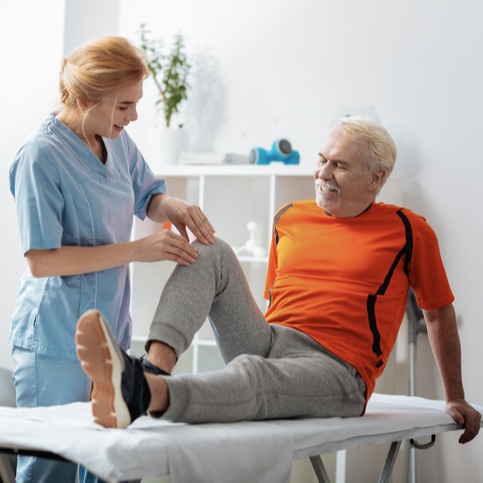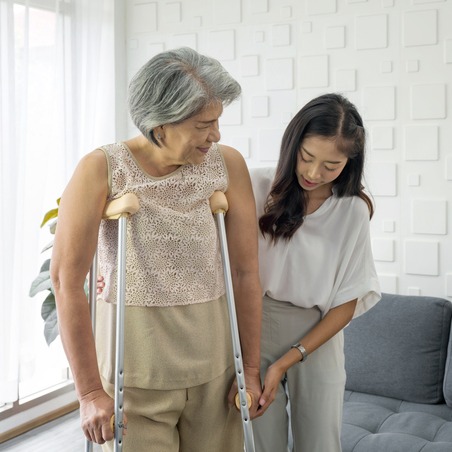
Knee discomfort or pain is a common and prevailing musculoskeletal issue that prompts individuals to seek medical attention. This ailment manifests as an achy sensation in the area behind and surrounding the kneecap, particularly when engaging in strenuous activities like climbing stairs, crouching, jogging, and carrying heavy objects while walking. Knee pain can limit your involvement in fun activities and hinder your ability to carry out routine duties. If left untreated, this condition may persist for an extended period, possibly spanning years. Various factors can cause knee pain, such as a stiff knee joint, improper positioning of the kneecap, flat arches, incorrect exercise form, and weak hip and knee muscles. However, regular exercise and physical activity can help alleviate knee pain and improve joint function. Are you struggling with knee discomfort and seeking practical exercises to alleviate the causes of knee pain? Fear not! This article will explore the top exercises that can help ease knee pain, allowing you to engage in physical activity with greater comfort and mobility.
Best Exercises To Prevent Knee Pain and Swelling
Warm-up First
Get ready for your workout by warming up your muscles with a low-impact activity such as strengthening exercises such as cycling on a stationary bike while pumping your arms. You can also do wall push-ups followed by calf raises. Warming up will enhance your workout performance, prepare your muscles for stretching, relieve pain, and reduce your chances of injury.
1. Bridging
To perform this exercise, lie on your back with your knees bent and feet flat on the ground. Use a pillow or towel roll to support your head. Keep your knees, feet, and hips aligned, and let your arms rest by your sides in a relaxed manner. Engage your buttocks muscles, lifting your hips towards the ceiling. Only lift your hips comfortably for your back without causing pain or discomfort. Pause briefly and slowly lower your hips back to the starting position. Aim for ten repetitions of this exercise, with three sets performed once a day. You can do this exercise 2-3 times a week for maximum benefit.
2. Quad Set
To perform this exercise, lie on a bed with one leg straightened out. Tighten the thigh muscle by pressing the back of the knee into the soft surface of the bed. Alternatively, you can place a small towel behind the knee and press against it to activate the muscle. Hold the knee injury in this position for 5 seconds, then relax. Repeat the exercise with the other leg. This simple yet effective exercise can help alleviate knee pain and strengthen your quadriceps muscles.
3. Straight Leg Raise
This exercise requires lying on your back and keeping the affected leg straight while bending the opposite knee. Engage the thigh muscles of the affected leg and slowly raise it in a controlled manner until it reaches the same height as the other knee. Hold the knee injuries. The knee is raised for 5 seconds while squeezing the thigh muscles, then relaxing the connect muscles and lowering the leg back to the floor.
4. Hip Abduction
Lie on your side with your bottom knee bent to provide balance. Use a pillow or towel roll to support your head. Straighten your top knee by tightening the muscles on the top of your knee, bracing your thigh. Flex your foot and lift your leg towards the ceiling, making sure not to lift it higher than the line of your body. Hold your lower leg in this position momentarily, then slowly lower your leg to the starting position. Repeat this exercise 10 times on each leg, with three sets performed once a day. You can do this exercise 2-3 times a week to improve your knee mobility and reduce pain.
5. Squats
You can use a kitchen counter or the back of a chair to support a sore knee for this exercise. Start by standing next to the support with your feet shoulder-width apart. Squat down to a comfortable distance between arch supports while keeping your body weight on your heels. Use only your legs to squat without relying on your arms to pull up or lower yourself. This exercise can help improve your knee strength and stability, prevent knee pain, and reduce knee pain.
6. Standing Calf Stretch
This exercise requires a wall and focuses on stretching the calf muscles and heel. Stand facing the wall with your unaffected leg forward and slightly bent at the knee. Keep the other leg straight behind you, with the knee raised, the heel flat on the floor and the toes pointed somewhat inward. Hold this position for 30 seconds while keeping your hands on the wall for support. After 30 seconds, relax for another 30 seconds. Aiming for two sets of 6 repetitions, 6 or 7 days per week, is recommended. Be sure not to arch your back during the exercise, as this can strain your lower back unnecessarily.
7. Clamshells
To do clamshells, lie on your side with a pillow or towel roll to support your neck. Bend your knees and keep your feet in line with your body. Keep your feet together and lift your top knee towards the ceiling; be careful not to roll your hips forward. Pause briefly before lowering your knee back to the starting position. Aim to do ten repetitions of this exercise on each leg, three sets once daily, and perform it 2-3 times more than a day per week.
8. Planks
The plank is a bodyweight exercise that can be done on the floor in a push-up position. To make the exercise easier, you can do it with your forearms resting and flat feet on the ground or your knees on the floor. Keep your body straight and tense your abs, glutes, and legs to maintain the position for 20 seconds. Take a break, then repeat the exercise.
9. Leg Curl
To do the leg curl, find something to hold onto for balance, like a counter or chair. Keep your back straight and bend your knee, bringing your heel up towards your buttock. Avoid moving and avoid putting weight down on your knee or hip as you lift your heel. Hold for a few seconds before lowering your heel to the floor. Repeat the exercise on your other leg.
10. Supine Hamstring Stretch
The supine hamstring stretch targets the muscles at the back of your thighs and knees. It would be best if you aimed to do this exercise 2 to 3 times per session and 4 to 5 times a week. To do the stretch, lie on your back and bend your knees, then lift one leg towards your chest. Hold onto the thigh with both hands (not the knee) and gently straighten the leg until you feel a stretch. Use a towel or an elastic bandage to aid in the stretch. Hold for 30 to 60 seconds, then repeat with the other leg.
Alternative Exercises for Relieve Pain
You can incorporate low-impact exercises into your workout routine to improve your knee strength. Unlike high-impact exercises such as running or jumping, low-impact exercises are generally gentler on your knee joints too. Popular low-impact exercises include yoga, tai chi, using an elliptical machine, swimming, stationary cycling, water aerobics, bearing weight down, and walking.
When to See a Doctor for knee problems
If you are experiencing continuous or escalating knee pain, you should contact a physician or a physical therapist for advice. It's always a good idea to consult a healthcare professional before beginning any exercise regimen or sports medicine, especially if you have an injury or are experiencing discomfort.
Conclusion
Incorporating exercises into your daily routine can significantly reduce knee pain and improve mobility. You can strengthen the muscles around the knee joint, increase flexibility, and reduce pain by combining strengthening, stretching, and low-impact exercises. Always consult a healthcare professional before starting any exercise program, particularly if you have an injury or persistent pain. With dedication and consistency, you can successfully manage knee pain and improve your quality of life.
What are the four common causes of knee pain?
Four common causes of knee pain include ACL injury, torn or meniscus tear, fractures, and knee bursitis. If you are experiencing knee pain, it can be caused by an ACL injury a tear in the anterior cruciate ligament. Another common cause is a torn meniscus, a cartilage tear that cushions the knee joint. Fractures, or broken bones in the knee, can also lead to knee pain. Lastly, knee bursitis, the inflammation of the small fluid-filled sacs cushion the knee joint, can also cause pain. If you are experiencing knee pain, seeking medical help to determine the exact cause and receive proper treatment is important.
How do I know if my knee pain is serious?
If you're experiencing severe pain, inability to bear weight, clicking or locking of the knee, deformity, or excessive swelling, it's important to seek medical help for your knee pain. These symptoms could indicate a serious underlying condition that requires professional evaluation and treatment. While minor knee aches can often resolve independently with rest and home care, knowing when to seek medical attention is crucial. If your knee pain interferes with your daily activities or you cannot perform normal movements, it's best to consult a healthcare provider. They can conduct a physical examination, order necessary tests, and provide appropriate treatment options to alleviate knee pain and promote healing. Remember, caring for your knees is essential for mobility and overall well-being.
How do you know what type of knee pain you have?
To determine the type of knee pain you have, it's important to consult a healthcare provider who can conduct a physical examination and order any necessary tests. They will be able to assess your symptoms, evaluate your medical history, and perform specific tests to diagnose the cause of your knee pain. By seeking medical help, you can better understand what is causing your pain and develop an appropriate treatment plan. Remember, it's crucial to communicate any concerns or questions you may have during your appointment. Your healthcare provider is there to serve you and guide you toward the best course of action for your knee pain. Don't hesitate to reach out and seek the help you need.
What causes knee pain without injury?
When experiencing knee pain without any known injury, you should consult a healthcare provider to determine the underlying cause and develop an appropriate treatment plan. There are several possible causes for knee pain without injury, such as arthritis, bursitis, tendonitis, or overuse. It's important to seek medical help to diagnose the cause of your knee pain accurately. A healthcare provider will conduct a physical examination and may order additional tests, such as X-rays or an MRI, to determine the exact cause of your pain. Once the cause is identified, they can develop a treatment plan tailored to your needs. This may include rest, physical therapy, medication, or other interventions. Remember, seeking medical help is the first step towards finding relief from your knee pain.
What is the most common reason for knee pain?
One of the most common reasons for knee pain is arthritis, which can cause inflammation and discomfort in your joints. Arthritis is a condition that affects many people, especially as they age. It can make simple tasks like walking or climbing stairs difficult and painful. If you are experiencing knee pain, seeking medical help to determine the cause and appropriate treatment is important. In the meantime, some exercises may help ease your knee pain and swelling. Strengthening exercises like leg lifts and squats can help stabilize and support your knees. Low-impact exercises like swimming or cycling can provide cardiovascular benefits without putting excessive stress on your knees. Always consult a healthcare professional before starting any new exercise program to ensure it is safe and appropriate for your condition.
What can cause knee pain without injury?
If you're experiencing knee pain without any injury, it could be caused by factors such as arthritis, overuse, or a history of knee problems. Arthritis, inflammation of the joints, can lead to knee pain and swelling. Overusing your knee by engaging in repetitive activities or putting excessive strain on it can also cause pain. Additionally, if you have had knee problems, such as a previous injury or surgery, you may be more prone to experiencing knee pain. It's important to listen to your body and take care of your knees, especially if you engage in activities that put stress on them. If your knee pain persists or worsens, it's always a good idea to seek medical advice to determine the underlying cause and receive appropriate treatment. Remember to take care of yourself and prioritize your health.
How can I stop knee pain?
Now that you know what can cause knee pain without injury let's talk about how you can stop knee pain. There are several steps you can take to alleviate knee pain and swelling. First, it's important to rest and avoid activities that cause pain. Applying ice to the knee several times daily can help reduce swelling while keeping the knee elevated can also provide relief. Using an elastic bandage or sleeve for support can provide stability. Over-the-counter pain relievers like ibuprofen or naproxen can help manage the pain. Additionally, warm up before exercising and cool down afterward to prevent further knee strain. Consider low-impact exercises like cycling or swimming, and run on soft surfaces instead of concrete or pavement. By following these steps, you can take control of your knee pain and prevent further discomfort.
What does it mean when your knees ache?
When your knees ache, it could indicate underlying conditions or overuse. Your knees are complex joints that support your body weight and allow you to move. The pain you feel may be caused by injuries, such as a torn meniscus or fractures, or mechanical problems, like a dislocated kneecap or changes in your walking due to hip or foot pain. Certain risk factors, such as excess weight, certain sports, and occupations that involve repetitive stress on the knees, can increase your chances of experiencing knee pain. To prevent knee pain and swelling, it is important to maintain a healthy weight, engage in conditioning and strengthening exercises, use proper technique and movement patterns, and include flexibility exercises in your workouts. If your knee pain persists or is accompanied by other symptoms, it is important to seek medical help for a proper evaluation and treatment.
What can cause a knee ache without injury?
Common causes of knee ache without injury include arthritis, overuse, and mechanical problems such as minor injuries such as a dislocated kneecap. If you're experiencing knee pain without a specific injury, it's important to consider these potential causes. Arthritis, such as osteoarthritis or rheumatoid arthritis, can cause inflammation and pain in the knee joint. Overuse of the knee, such as repetitive motions or excessive strain, can also lead to discomfort. Mechanical issues like a dislocated kneecap or problems with the alignment of the knee joint can contribute to knee aches as well. If you're serving others and experiencing knee pain, listening to your body and seeking medical attention if the pain persists or worsens is crucial. Resting, applying ice, and using over-the-counter pain relievers can help alleviate symptoms, but consulting a healthcare provider is essential for proper diagnosis and treatment.
What to do for an aching knee?
If you're experiencing aching in your knee, it's important to rest, elevate the knee, and apply ice to help reduce discomfort and inflammation. Resting will give your knee time to heal and prevent further strain. Elevating your knee will help reduce swelling by allowing fluid to drain away from the area. Applying ice will help numb the pain and reduce inflammation. Additionally, you can take over-the-counter pain relievers like ibuprofen or naproxen to help manage the pain. Listening to your body and avoiding activities that worsen the pain is important. If the pain persists or worsens, it's a good idea to seek medical help to determine the underlying cause and receive appropriate treatment. Remember to always take care of yourself and prioritize your health.
Is it normal for knees to ache?
If you're experiencing aching knees, you may wonder if it's normal. Well, the answer is it depends. While some occasional knee pain and discomfort can be considered normal, persistent or severe knee pain is not something you should ignore. Various factors, such as injuries, arthritis, or overuse, can cause aching knees. Listening to your body and noticing any changes or worsening symptoms is important. If your knee pain prevents you from performing daily activities or you notice any swelling, redness, or instability, it's time to seek medical help. A healthcare provider can evaluate your condition, perform necessary tests, and provide appropriate treatment options. Caring for your knees is essential for an active and fulfilling life.
How can I relieve knee joint pain?
To relieve knee joint pain, you can try applying ice packs to reduce inflammation and elevate your knee to reduce swelling. These simple home remedies can help alleviate discomfort and promote healing. Ice packs can be applied for 15-20 minutes daily to reduce swelling and numb the area. Elevating your knee above the level of your heart can also help reduce swelling by promoting proper blood flow. Additionally, you may consider using over-the-counter pain relievers like ibuprofen or naproxen to help manage the pain. Remember to rest your knee and avoid activities that worsen the pain. If your symptoms persist or worsen, seeking medical attention for further evaluation and treatment is important.
What is the main cause of knee joint pain?
The main cause of knee joint pain is often related to injuries or conditions such as arthritis, and seeking medical attention is important for proper diagnosis and treatment. When you experience knee pain can be a sign of an underlying problem that needs to be addressed. Injuries like ACL tears, torn meniscus, or fractures can cause severe knee pain and instability. Conditions like osteoarthritis or rheumatoid arthritis can also lead to chronic knee pain. It is crucial to consult a healthcare professional who can evaluate your symptoms and provide appropriate treatment options. They may recommend physical therapy, medication, or surgery to alleviate knee pain and improve your quality of life. Remember, taking care of your knee health is essential for staying active and serving others.
Sources
https://www.healthline.com/health/exercises-for-knee-pain https://www.ncbi.nlm.nih.gov/pmc/articles/PMC5074793 https://www.versusarthritis.org/media/21787/kneepain-exercise-sheet.pdf https://www.hss.edu/article_stretches-exercises-knee-pain.asp https://www.cdc.gov/arthritis/communications/features/arthritis-exercise.html






